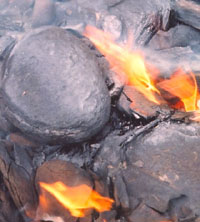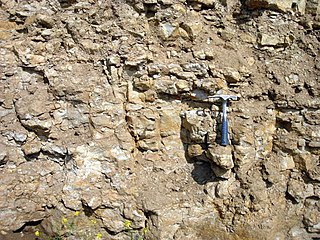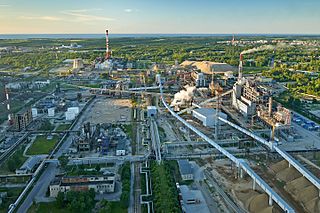
Oil shale is an organic-rich fine-grained sedimentary rock containing kerogen from which liquid hydrocarbons can be produced. In addition to kerogen, general composition of oil shales constitutes inorganic substance and bitumens. Based on their deposition environment, oil shales are classified as marine, lacustrine and terrestrial oil shales. Oil shales differ from oil-bearing shales, shale deposits that contain petroleum that is sometimes produced from drilled wells. Examples of oil-bearing shales are the Bakken Formation, Pierre Shale, Niobrara Formation, and Eagle Ford Formation. Accordingly, shale oil produced from oil shale should not be confused with tight oil, which is also frequently called shale oil.

Peak oil is the moment at which extraction of petroleum reaches a rate greater than that at any time in the past and starts to permanently decrease. It is related to the distinct concept of oil depletion; while global petroleum reserves are finite, the limiting factor is not whether the oil exists but whether it can be extracted economically at a given price. A secular decline in oil extraction could be caused both by depletion of accessible reserves and by reductions in demand that reduce the price relative to the cost of extraction, as might be induced to reduce carbon emissions.
Unconventional oil is petroleum produced or extracted using techniques other than the conventional method. Industry and governments across the globe are investing in unconventional oil sources due to the increasing scarcity of conventional oil reserves. Unconventional oil and gas have already made a dent in international energy linkages by reducing US energy import dependency.
Shale oil is an unconventional oil produced from oil shale rock fragments by pyrolysis, hydrogenation, or thermal dissolution. These processes convert the organic matter within the rock (kerogen) into synthetic oil and gas. The resulting oil can be used immediately as a fuel or upgraded to meet refinery feedstock specifications by adding hydrogen and removing impurities such as sulfur and nitrogen. The refined products can be used for the same purposes as those derived from crude oil.

Oil shale geology is a branch of geologic sciences which studies the formation and composition of oil shales–fine-grained sedimentary rocks containing significant amounts of kerogen, and belonging to the group of sapropel fuels. Oil shale formation takes place in a number of depositional settings and has considerable compositional variation. Oil shales can be classified by their composition or by their depositional environment. Much of the organic matter in oil shales is of algal origin, but may also include remains of vascular land plants. Three major type of organic matter (macerals) in oil shale are telalginite, lamalginite, and bituminite. Some oil shale deposits also contain metals which include vanadium, zinc, copper, and uranium.

The oil shale industry is an industry of mining and processing of oil shale—a fine-grained sedimentary rock, containing significant amounts of kerogen, from which liquid hydrocarbons can be manufactured. The industry has developed in Brazil, China, Estonia and to some extent in Germany and Russia. Several other countries are currently conducting research on their oil shale reserves and production methods to improve efficiency and recovery. Estonia accounted for about 70% of the world's oil shale production in a study published in 2005.

Shale oil extraction is an industrial process for unconventional oil production. This process converts kerogen in oil shale into shale oil by pyrolysis, hydrogenation, or thermal dissolution. The resultant shale oil is used as fuel oil or upgraded to meet refinery feedstock specifications by adding hydrogen and removing sulfur and nitrogen impurities.
Oil shale economics deals with the economic feasibility of oil shale extraction and processing. Although usually oil shale economics is understood as shale oil extraction economics, the wider approach evaluates usage of oil shale as whole, including for the oil-shale-fired power generation and production of by-products during retorting or shale oil upgrading processes.

The Piceance Basin is a geologic structural basin in northwestern Colorado, in the United States. It includes geologic formations from Cambrian to Holocene in age, but the thickest section is made up of rocks from the Cretaceous Period. The basin contains reserves of coal, natural gas, and oil shale. The name likely derives from the Shoshoni word /piasonittsi/ meaning “tall grass”.
The American Shale Oil, LLC (AMSO), originally known as EGL Oil Shale, LLC, was a developer of in-situ shale oil extraction technology based in Rifle, Colorado. It was owned by Genie Energy and Total S.A. In May 2016, Genie Energy announced that the AMSO project was closing.
The TOSCO II process is an above ground retorting technology for shale oil extraction, which uses fine particles of oil shale that are heated in a rotating kiln. The particularity of this process is that it use hot ceramic balls for the heat transfer between the retort and a heater. The process was tested in a 40 tonnes per hour test facility near Parachute, Colorado.

Colony Shale Oil Project was an oil shale development project at the Piceance Basin near Parachute Creek, Colorado. The project consisted of an oil shale mine and pilot-scale shale oil plant, which used the TOSCO II retorting technology, developed by Tosco Corporation. Over time the project was developed by a consortium of different companies until it was terminated by Exxon on 2 May 1982 a day which is known amongst locals as "Black Sunday".
Chevron CRUSH is an experimental in situ shale oil extraction technology to convert kerogen in oil shale to shale oil. The name stands for Chevron's Technology for the Recovery and Upgrading of Oil from Shale. It is developed jointly by Chevron Corporation and the Los Alamos National Laboratory.
ExxonMobil Electrofrac is an in situ shale oil extraction technology proposed by ExxonMobil for converting kerogen in oil shale to shale oil.
The Superior multimineral process is an above ground shale oil extraction technology designed for production of shale oil, a type of synthetic crude oil. The process heats oil shale in a sealed horizontal segmented vessel (retort) causing its decomposition into shale oil, oil shale gas and spent residue. The particularities of this process is a recovery of saline minerals from the oil shale, and a doughnut-shape of the retort. The process is suitable for processing of mineral-rich oil shales, such as in the Piceance Basin. It has a relatively high reliability and high oil yield. The technology was developed by the American oil company Superior Oil.
The Union process was an above ground shale oil extraction technology for production of shale oil, a type of synthetic crude oil. The process used a vertical retort where heating causes decomposition of oil shale into shale oil, oil shale gas and spent residue. The particularity of this process is that oil shale in the retort moves from the bottom upward to the top, countercurrent to the descending hot gases, by a mechanism known as a rock pump. The process technology was invented by the American oil company Unocal Corporation in late 1940s and was developed through several decades. The largest oil shale retort ever built was the Union B type retort.
Omnishale process is an in situ shale oil extraction technology to convert kerogen in oil shale to shale oil. This process is classified as an externally generated hot gas technology. The technology is developed by General Synfuels International, a subsidiary of Earth Search Sciences.

Genie Energy Ltd. is an American energy company headquartered in Newark, New Jersey. It is a holding company comprising Genie Retail Energy, Genie Retail Energy International, Genie Energy Services, and Genie Energy Oil and Gas. Michael Stein is the Chief Executive Officer, Genie Energy Ltd.
Oil shale in Morocco represents a significant potential resource. The ten known oil shale deposits in Morocco contain over 53.381 billion barrels of shale oil. Although Moroccan oil shale has been studied since the 1930s and several pilot plants have extracted shale oil from the local formations, commercial extraction was not underway as of 2011.
The history of the oil shale industry in the United States goes back to the 1850s; it dates back farther as a major enterprise than the petroleum industry. But although the United States contains the world's largest known resource of oil shale, the US has not been a significant producer of shale oil since 1861. There were three major past attempts to establish an American oil shale industry: the 1850s; in the years during and after World War I; and in the 1970s and early 1980s. Each time, the oil shale industry failed because of competition from cheaper petroleum.









